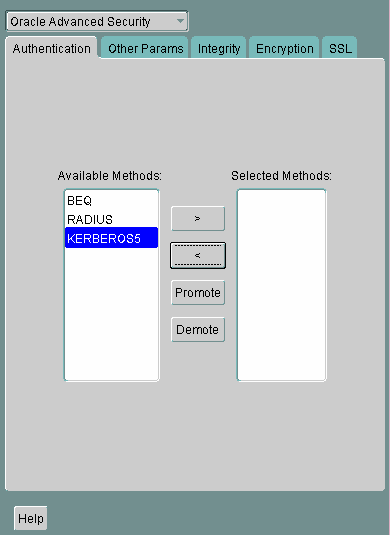| Oracle® Database Advanced Security Administrator's Guide 10g Release 1 (10.1) Part Number B10772-01 |
|
|
View PDF |
| Oracle® Database Advanced Security Administrator's Guide 10g Release 1 (10.1) Part Number B10772-01 |
|
|
View PDF |
This chapter describes how to configure multiple authentication methods under Oracle Advanced Security, and how to use conventional user name and password authentication, even if you have configured another authentication method. This also chapter describes how to configure your network so that Oracle clients can use a specific authentication method, and Oracle servers can accept any method specified.
This chapter contains the following topics:
To connect to an Oracle database server using a user name and password when an Oracle Advanced Security authentication method has been configured, disable the external authentication (See: "Disabling Oracle Advanced Security Authentication" ).
With the external authentication disabled, a user can connect to a database using the following format:
% sqlplus username/password@net_service_name
For example:
% sqlplus scott/tiger@emp
|
Note: You can configure multiple authentication methods, including both externally authenticated users and password authenticated users, on a single database. |
Use Oracle Net Manager to disable authentication methods (See "Starting Oracle Net Manager"):

Text description of the illustration auth0001.gif
The sqlnet.ora file is updated with the following entry:
SQLNET.AUTHENTICATION_SERVICES = (NONE)
Many networks use more than one authentication method on a single security server. Accordingly, Oracle Advanced Security lets you configure your network so that Oracle clients can use a specific authentication method, and Oracle database servers can accept any method specified.
You can set up multiple authentication methods on both client and server systems either by using Oracle Net Manager, or by using any text editor to modify the sqlnet.ora file.
Use Oracle Net Manager to add authentication methods to both clients and servers (See "Starting Oracle Net Manager"):
The sqlnet.ora file is updated with the following entry, listing the selected authentication methods:
SQLNET.AUTHENTICATION_SERVICES = (RADIUS|KERBEROS5)
|
Note:
|
This section describes the parameters you must set to configure Oracle Database for network authentication, using the following tasks:
See Also:
|
The following parameter must be set in the sqlnet.ora file for all clients and servers to enable each to use a supported authentication method:
SQLNET.AUTHENTICATION_SERVICES=(oracle_authentication_method)
For example, for all clients and servers using Kerberos authentication, the sqlnet.ora parameter must be set as follows:
SQLNET.AUTHENTICATION_SERVICES=(KERBEROS5)
To verify that REMOVE_OS_AUTHENT is not set to TRUE, add the following parameter to the initialization file--in each database instance--when you configure the authentication method:
REMOTE_OS_AUTHENT=FALSE
If REMOTE_OS_AUTHENT is set to FALSE, and the server cannot support any of the authentication methods requested by the client, the authentication service negotiation fails and the connection terminates.
If the parameter is set as follows in the sqlnet.ora file on either the client or server, the database attempts to use the supplied user name and password to login the user:
SQLNET.AUTHENTICATION_SERVICES=(NONE)
If REMOTE_OS_AUTHENT is set to FALSE, however, the connection fails.
Authentication service-based user names can be long, and Oracle user names are limited to 30 characters. Oracle Corporation strongly recommends that you enter a null value for the OS_AUTHENT_PREFIX parameter in the initialization file used for the database instance as follows:
OS_AUTHENT_PREFIX=""
To create a user, launch SQL*Plus and enter the following:
SQL> CREATE USER os_authent_prefix username IDENTIFIED EXTERNALLY;
When OS_AUTHENT_PREFIX is set to a null value (" "), enter the following to create the user king:
SQL> CREATE USER king IDENTIFIED EXTERNALLY;
The advantage of creating a user in this way is that the administrator no longer needs to maintain different user names for externally identified users. This is true for all supported authentication methods.